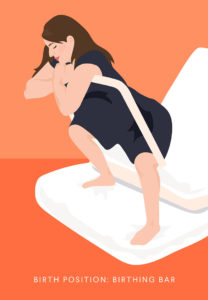In a previous post, we explored the emotional signposts of a typical labour: what happens during the first stage, while your cervix is opening and thinning to allow the baby to descend into the birth canal. Once that process is completed, the second stage begins, and soon it will be time to push that baby out!
The first thing to know about pushing is that it doesn’t have to begin the instant dilation is complete. Many people experience a pause in the rhythm of labour between the first and second stages – which can be particularly welcome if your experience of transition was intense! This happens because once your baby’s head is able to start moving down through your cervix, it leaves some space at the top of your uterus (the “fundus”). Throughout the first stage of labour, the contractions have not only been dilating your cervix, they have been drawing the muscles of the uterus up toward the fundus, creating a thick, strong “launching pad” of muscle to push the baby down. When that downward movement begins, leaving room for the baby to stretch their legs, the uterine muscles are able to relax a bit before tightening up again to keep the baby moving downward.
If this pause happens to you, go with it! It will allow you to rest and gather your strength for the pushing phase. Your body is still doing its job, gathering itself to push your baby out smoothly and efficiently. Letting the baby “labour down” during this pause is much easier for everyone than immediately starting to push.
Once the uterus has begun to contract again as the baby moves down the birth canal, you may feel a powerful, irresistible urge to push. Many people find that the pushing phase of labour is significantly more straightforward and satisfying than the first stage. This is not everyone’s experience, however. Cynthia Gabriel, author of Natural Hospital Birth: The Best of Both Worlds, estimates that about one out of every four birthing people finds pushing harder than dilation. (I was one of them. Pushing sucked.)
Many hospitals still practice “directed pushing,” in which the person in labour is encouraged to hold their breath for a count of ten while bearing down as hard as they can, at least twice during each contraction. Most of the time, if you have a strong urge to push and each push is moving the baby down, directed pushing is not necessary. Arguably, it could even limit the baby’s oxygen supply, since you are being encouraged to hold your breath. If you feel that you are pushing well on your own and there is no concern about the baby’s condition, feel free to ask your nurses to let you push when your body tells you to.
Contrary to what you may see on TV, lying on your back in a hospital bed is not usually the best position for pushing, if you can possibly help it. After all, your baby is trying to move down, so work with gravity if you can! Many hospitals nowadays have a birthing bar that can be attached to the bed, so you can be supported in a squatting position, which will open your pelvis and allow as much room as possible for the baby’s head and body to move through. If you are giving birth at home or at a birth center, your midwives may have a birth stool that you can sit on to push.

In real life, people who are pushing out babies generally don’t look quite this calm, nor are they probably wearing pants.
I know doulas who have attended births where babies were born while their parents were standing up, squatting on the floor, any number of positions that were not “on your back in bed” but which worked for that person’s body and their baby! (Footnote: in some specific situations when your baby’s head needs to move around your pubic bone, lying on your back curled around your belly, with your elbows hooked under your knees, can be very effective – even if it seems hopelessly retro!)
On the other hand, if your baby is coming very quickly, a different set of positions may be helpful. Although it’s much preferable to getting stuck, a baby coming too fast can damage the perineum and cause temporary difficulties with the baby’s heart and lungs immediately following birth. If this happens to you, moving into a position such as side-lying or hands and knees – which reduces the effect of gravity while still allowing your pelvis to open – will help the baby to come out in a smoother and more controlled way, while your nurse or midwife supports your perineum to reduce tearing.
And what happens if the pushing phase is slow and the baby isn’t moving down much? In that case, changing positions often may be the key to getting the baby unstuck. (I pushed for three hours and in pretty much every imaginable position.) If spontaneous pushing isn’t doing the job, or the laboring person is tired or not perceiving the urge to push, this may be the time for the kind of directed pushing described above. And if it just isn’t happening, other strategies may be called for – episiotomy, use of the vacuum, or an epidural to allow swollen cervical tissue to relax – but only with your informed consent!
Regardless of whether pushing takes five minutes or five hours, whether baby comes in the squatting, side-lying or any other position, the moment when it’s over – when your baby emerges into your care team’s waiting hands and they scoop them up and drop that warm, squirming, slimy, new little person on your chest – will be a moment of intense physical relief and overwhelming emotion. Enjoy!
